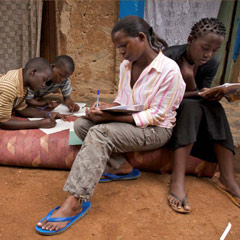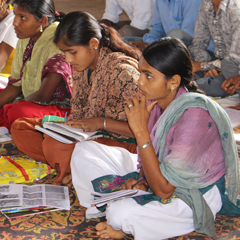
Total Awarded: $19.2 million
Duration: 2011 - 2016
Total Grants: 54 grants
Geographic Focus: Democratic Republic of Congo, India, Kenya, Malawi, Nigeria, Rwanda, Tanzania, Uganda
Background
Millions of children globally are struggling to obtain meaningful education due to limited access to schools, poor quality of teaching, and lack of relevance between curricula and labor market needs. In 2011, MacArthur joined with several other donors to found the Partnership to Strengthen Innovation and Practice in Secondary Education (PSIPSE), a collaborative that seeks to increase secondary education access and improve learning outcomes for marginalized populations in under-resourced countries, including the Democratic Republic of the Congo, India, Kenya, Malawi, Nigeria, Rwanda, Tanzania, and Uganda. PSIPSE supports the development and testing of innovative models to address barriers to participation and achievement in secondary education, facilitates the scale-up of effective interventions through systematic change in target countries, and promotes efforts to build evidence regarding what works in secondary education.
What We Evaluated
In 2014, Mathematica Research Policy was hired by the PSIPSE to serve as its external evaluation partner. In this role, Mathematica produced a literature review on existing evidence of initiatives focused on promoting secondary education, assisted the collaborative with refining its theory of change based on this evidence, and developed a monitoring, evaluation, and learning framework for the PSIPSE that outlines an approach for collecting data about the work of grantees that can be used to facilitate cross-cutting learning and fostering scale-up. Mathematica is also supporting the collaborative in implementing the framework and sharing information on PSIPSE’s approach and progress with a variety of stakeholders.
What We Learned
The literature review identified relatively few strategies for which there are sufficient, rigorous evidence to argue for the scale-up of post-secondary education interventions. The monitoring report found that nearly all PSIPSE grantees are conducting needs assessments, monitoring participant progress, and obtaining qualitative feedback. This bodes well for encouraging a culture of learning and monitoring progress to adjust implementation. However, few are engaged in rigorous impact evaluations. Furthermore, PSIPSE grantees often find their monitoring, evaluation, and learning budget to be inadequate, even when allocating up to 15 percent of project resources towards these activities.
PSIPSE grantees also identified the need for assistance with program design; how to build monitoring plans; and how to better disseminate information and learnings they’ve gathered through their work.
The majority of PSIPSE funding supports efforts to improve student achievement and prepare youth for life after secondary school. Most grantees combined multiple intervention approaches to achieve their goals. The most common combination of interventions included (1) non-academic support for youth and (2) parent and community engagement.
Monitoring data gathered across the PSIPSE portfolio surfaced common trends with regard to interventions aiming to promote girls’ secondary education, including:
- When aiming to increase participation, it is important to understand and address both supply and demand sides of barriers to educational access, it is vital to work with men as well as women in effort to shift community attitudes related to girls’ education, and it is imperative to not only build overarching demand for secondary education among girls but directly tackle key barriers to access, such as early (or repeat) pregnancies.
- With regard to improving quality, training teachers to develop lessons for mixed-ability classrooms is “difficult to achieve in the best of circumstances,” but doubly hard when classes are large, materials are scarce, and teacher capacity is low. Heavy workloads minimize the time teachers have available for in-person training. Opting for alternative/blended training models may help address this challenge, especially if building in strategies to address technological obstacles that ICT-based trainings face in low-resource settings.
- In order to enhance the relevance of girls’ post-secondary education, life skills training needs to be paired with more formal entrepreneurship or workforce development training to support transitions into “decent work” following secondary school. There is also a strong need for entrepreneurship training in post-conflict areas.
- Designing sustainable programs must first start with building ownership among local stakeholders. For instance, sharing evidence of program effectiveness can get local government officials and community leaders on board and ensure program sustainability. Developing strategic messaging for governments - on issues aligned with their priorities – using tailored communications can be a helpful approach.
More Information
- Learnings from working as a Donor Collaborative: Catalyzing Change in Secondary Education in African and India (February 2017)
- PSIPSE 2016 Monitoring Report (August 2017)
- Policies and Programs to Improve Secondary Education in Developing Countries: A Review of the Evidence (August 2017)
- Improving Teacher Quality At Scale: 10 Tips from Practitioners (February, 2018)



